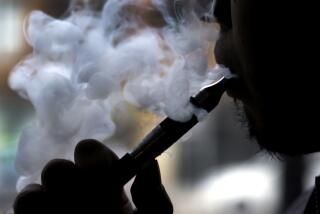Tobacco Trial Smoking Out Damaging Memos
- Share via
ST. PAUL, Minn. — During the first week of Minnesota’s massive case against the tobacco industry, attorneys for the state started unveiling some of the “smoking howitzer” documents that Minnesota Atty. Gen. Hubert H. Humphrey III told members of Congress they needed to see before making a decision on the proposed $368.5-billion national tobacco settlement.
Among the potentially most damaging documents are those showing that the cigarette companies knew years ago from their own internal research that smokers using supposedly safer “low-tar, low-nicotine” cigarettes compensate in a variety of ways to get the desired level of nicotine to satisfy their cravings. The companies realized that smokers take longer and deeper puffs, smoke more cigarettes and cover small ventilation holes around the filters designed to reduce cancer-causing agents.
The documents were introduced during the testimony of the trial’s first witness, Dr. Richard D. Hurt, director of the Mayo Clinic’s Nicotine Dependence Center.
Such documents and testimony clearly are important in the case where Minnesota is seeking compensatory and punitive damages from the industry for violations of antitrust and consumer-protection laws, in part because the cigarette companies allegedly deceived the public about the hazards of smoking and consciously decided against developing a safe cigarette.
But the material also has ramifications in the congressional debate and for health policy concerns. About 75% of all cigarettes being smoked in the U.S. are classified as “low tar,” and there is considerable debate in public health circles about how the government decides what sort of cigarette is entitled to such classification.
The Federal Trade Commission announced in September that it plans to change its system for measuring tar and nicotine to better reflect the varying ways that people smoke.
The vent holes supposedly permit air to enter the smoke stream, thus reducing the volume of smoke. Machines used by the Federal Trade Commission in the U.S. and by British agencies to test the tar and nicotine content of cigarettes do not cover the vent holes.
But, in a 1978 internal report, D. E. Creighton, a researcher for British American Tobacco Co., or BATCO, noted that during 10 years of study by the company, “no smoker has yet been observed who smokes with the same pattern as a smoking machine.”
Another BATCO researcher, Colin C. Greig, a participant in several company conferences on smoker behavior in the early 1980s, noted that “over the last 15 years . . . [human] puff volumes have risen as inexorably as machine deliveries have declined.”
Greig described the potential economic benefits to the company by quoting writer Oscar Wilde, who said a cigarette delivered “exquisite” pleasure but left one unsatisfied. Then Greig, added:
“Let us provide the exquisiteness and hope that they, our consumers, continue to remain unsatisfied. All we would want then is a larger bag to carry the money to the bank.”
Hurt said that while Greig’s comments were particularly eloquent, similar sentiments were reflected in memos from the other cigarette companies.
Michael Ciresi, a lawyer for the plaintiffs, introduced these documents and 40 others during two days of testimony by Hurt, an expert on nicotine addiction.
Ciresi asked the doctor what effect low-tar, low-nicotine cigarettes have had on public health.
Hurt responded: “It has encouraged people to continue to smoke who would otherwise try to stop smoking and reassured people that they’re smoking a safer cigarette when it’s not. So it’s been detrimental to public health.”
He said the proof can be seen easily from the fact that lung cancer rates have not declined since the advent of low-tar, low-nicotine cigarettes since the surgeon general’s 1964 report, the first U.S. government warning that smoking could be hazardous to health.
As a general rule, the term “low tar” means 7 to 15 milligrams per cigarette, and “ultra low tar” means 6 or fewer milligrams.
In recent years, there has been a growing body of research--including a study issued in November by the Centers for Disease Control and Prevention--concluding that so-called light cigarettes may be as hazardous as regular ones because many smokers use them in a way that defeats the advertised purpose.
The proposed FTC testing method is designed to give smokers a better idea of how much tar and nicotine they are taking in per cigarette.
The FTC system would still be inadequate, however, said Jack E. Henningfield, former director of the National Institute of Drug Abuse and now an associate professor at Johns Hopkins Medical School in Baltimore. “The proposed fix by the FTC is inadequate, in part because it does not address the issue of labeling--that is, what it takes to call something ‘low’ or ‘ultra low’--and it does not address the vent-blocking issue,” Henningfield said Sunday.
More to Read
Sign up for Essential California
The most important California stories and recommendations in your inbox every morning.
You may occasionally receive promotional content from the Los Angeles Times.












